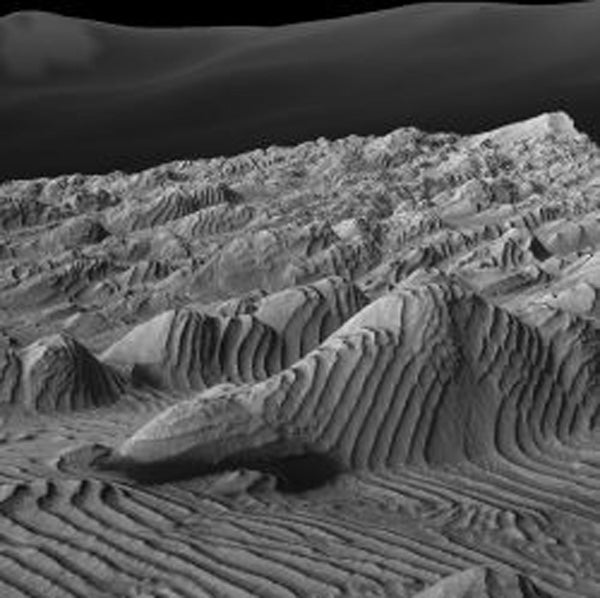Using stereo topographic maps obtained by processing data from the high-resolution camera onboard NASA’s Mars Reconnaissance Orbiter, Caltech scientists Kevin Lewis, Oded Aharonson, and John Grotzinger, identified and measured layered rock outcrops within four craters in the Red Planet’s Arabia Terra region. The layering in different outcrops occurs at scales ranging from a few meters to tens of meters, but at each location the layers all have similar thicknesses and exhibit similar features.
Based on a pattern of layers within layers measured at Becquerel crater, the scientists propose that each layer formed during a period of about 100,000 years and that the same cyclical climate changes produced these layers.
In addition, every 10 layers were bundled together into larger units, which were laid down during an approximately one-million-year period. In the Becquerel crater, the 10-layer pattern is repeated at least 10 times. This one-million-year cycle corresponds to a known pattern of change in Mars’ obliquity caused by solar system dynamics .
“Due to the scale of the layers, small variations in Mars’ orbit are the best candidate for the implied climate changes. These are the very same changes that have been shown to set the pacing of ice ages on the Earth and can also lead to cyclic layering of sediments,” said Lewis.
Earth’s tilt on its axis varies between 22.1 and 24.5° over a 41,000-year period. The tilt is responsible for seasonal variation in climate, because the portion of Earth that is tipped toward the Sun receives more sunlight hours during a day and gradually changes throughout the year. During phases of lower obliquity, polar regions are less subject to seasonal variations, leading to periods of glaciation.
Mars’ tilt varies by tens of degrees throughout a 100,000-year cycle, producing even more dramatic variation. When the obliquity is low, the poles are the coldest places on the planet, while the Sun is located near the equator all the time. This could cause volatiles in the atmosphere, like water and carbon dioxide, to migrate poleward, where they’d be locked up as ice.
When the obliquity is higher, the poles get relatively more sunlight, and those materials would migrate away. “That affects the volatiles budget. If you move carbon dioxide away from the poles, the atmospheric pressure would increase, which may cause a difference in the ability of winds to transport and deposit sand,” Aharonson said. This is one effect that could change the layers’ deposition rate such as those seen by the researchers in the four craters.
The changing tilt would also change the stability of surface water, which alters the ability of sand grains to stick together and cement to form the rock layers.
“The whole climate system would be different,” Aharonson said.
However, such large climate changes would influence a variety of geologic processes on the surface. While the researchers cannot tie the formation of the rhythmic bedding on Mars to any particular geologic process, “strength of the paper is that we can draw conclusions without having to specify the precise depositional process,” Aharonson said.
“This study gives us a hint of how the ancient climate of Mars operated and shows a much more predictable and regular environment than you would guess from other geologic features that indicate catastrophic floods, volcanic eruptions, and impact events,” Lewis said. “More work will be required to understand the full extent of the information contained within these natural geologic archives,” he said.
“One of the fun things about this project is that we were able to use techniques on Mars that are the bread and butter of studies of stratigraphy on Earth,” said Aharonson. “We substituted a high-resolution camera in orbit around Mars and stereo processing for a geologist’s Brunton Compass and mapboard, and were able to derive the same quantitative information on the same scale. This enabled conclusions that have qualitative meaning similar to those we chase on Earth.”










